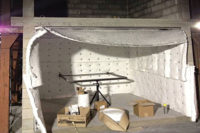ICC Says Flame Retardants to Stay in Foam Insulation

The International Code Council has determined that flame retardants are to remain in foam insulation. The ruling came during ICC’s Public Comment Hearings in Atlantic City, N.J., October 2-9. These hearings, which are the final stop for pending code changes, were formerly called the Final Action Code hearings.
This action represents a major victory for EIMA and its allies, all members of the Energy Efficient Code Coalition. The vote on the two proposals (RB 163 and RB 164) to ban flame retardants in the International Residential Code occurred on October 4. Only about a dozen persons voted in favor of the changes; the remainder, well over 100, voted against.
At the Committee Action Hearings in Dallas last April, the first step in code development, the IRC Building Committee voted down these proposals. They were brought back for consideration by the sponsors of the proposals submitting ‘public comments’ on the rejected proposals, a procedure that is permitted by the International Code Council’s codified rules for code development. Under these rules, defeated proposed code changes can have a public comment submitted. They then can be heard at the subsequent Public Comment Hearings, with a vote held by those code officials in attendance at the full assembly on whether to support the committee’s action at the previous hearing or to review the public comments on the previously defeated code changes.
The EEFC strategy at this hearing was largely developed by Jess Beitel, EIMA’s fire code consultant, and Lorraine Ross, a consultant for Dow. The testimony presented by the 11 representatives for EEFC was well-coordinated, non-redundant and concise. EEFC witnesses addressed fire and toxicology concerns previously raised by the code change proponents, including three industrial hygienists, one toxicologist and a representative from Underwriters Laboratory.
Also, three others felt strongly enough to lend support: Mike Beaton of Intertek, a representative from the Vinyl Siding Institute, and J.C. Harrington of FM Global. During the EEFC testimony there was reverent silence as the code officials focused on the messages.
The opposition sent only two to testify this time and their points, which were anticipated by EEFC in advance, were easily neutralized by the 14 persons who testified first to ask the voting code officials to uphold the expert committee decision to disapprove these proposals.
Looking for a reprint of this article?
From high-res PDFs to custom plaques, order your copy today!







